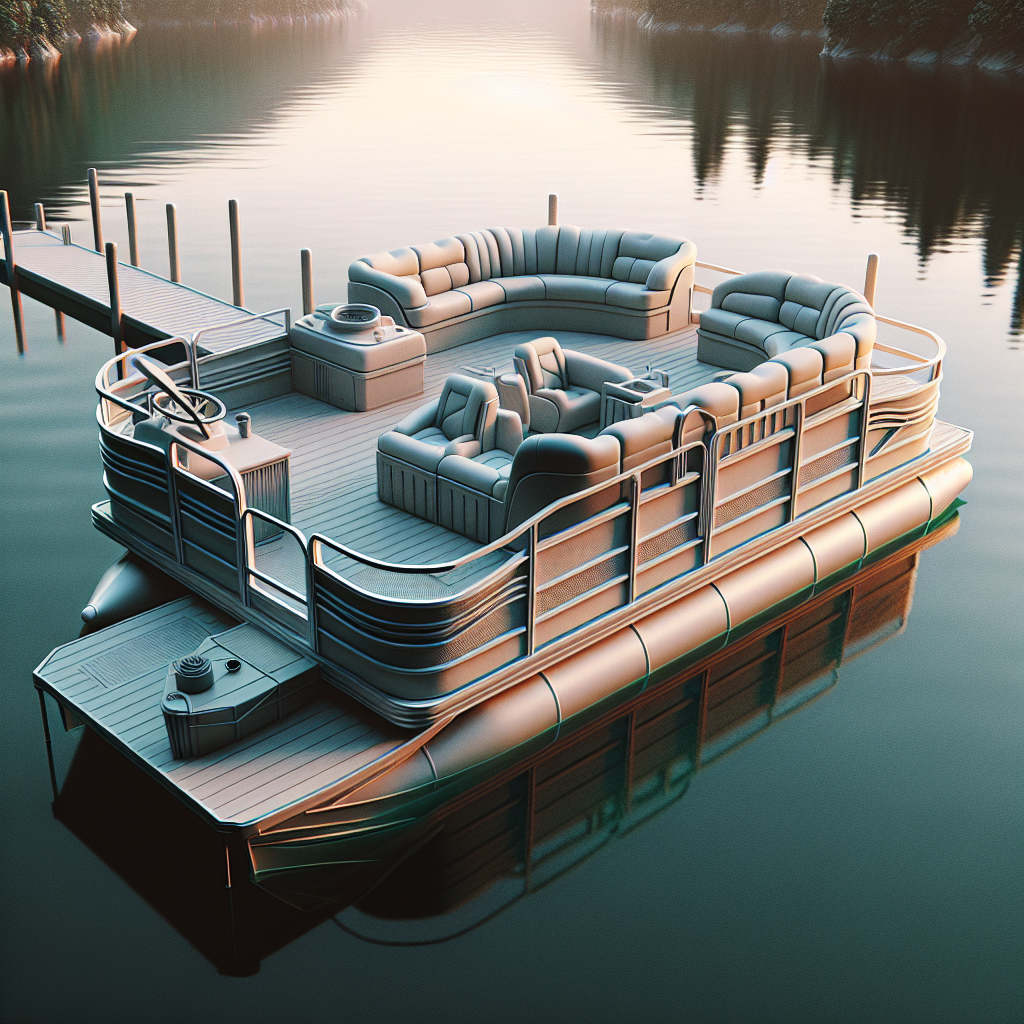Introduction to Pontoon Boats and Drainage Systems
A. Understanding Pontoon Boats
Pontoon boats are watercraft that use buoyancy tubes or pontoons to stay afloat rather than traditional flat hulls. They have become increasingly popular in recent years due to their capacity to carry large groups of people and their stability in the water. Pontoon boats come in various sizes and styles, providing options for different types of water activities.
B. Importance of Drainage in Boats
Water is the enemy of most boats. If water accumulates in your pontoon boat, it can destabilize the craft, make it heavier and potentially damage the vessel’s integrity if left unattended. Drainage systems in pontoon boats are therefore essential, aiding in removing such water when it collects in the boat’s interior. In case of heavy rains or any other form of water collection within the pontoon, drainage systems help move excess water out.
C. Overview of Drain Plugs in Marine Vessels
Drain plugs are valves or screws that control and permit the water to flow out from the pontoon. Drain plugs can be attached to a drainage system to redirect water out of the vessel when it accumulates in the boat’s interior. These can vary across different boat models, and a few boats may not feature drain plugs at all. To navigate through this essential need for drainage, an understanding of the drain plugs within pontoon boats is necessary.
Do Pontoon Boats Have Drain Plugs?
Pontoon boats are known for their stability, spaciousness, and versatility. But one question often arises for first-time pontoon owners: Do pontoon boats have drain plugs?
The short and straightforward answer is yes, most pontoon boats have drain plugs. These plugs are an essential aspect of a boat’s drainage system and help to prevent water accumulation and damage to the vessel.
Standard Features in Pontoon Boats
In most cases, drain plugs are standard on all pontoon boats. They are typically located at the rear end of the boat, below the waterline. Drain plugs are often made of rubber or plastic and come in different shapes and sizes depending on the manufacturer. Some manufacturers may even include an extra plug as part of their package.
The Role of Drain Plugs in Pontoon Boats
Drain plugs serve a vital purpose in pontoon boats. They are designed to allow water to escape the hull and provide an easy way to flush the boat’s system of excess water. Drain plugs are also helpful in situations where water builds up within the boat due to rain, waves, or accidental spillage.
Variations Among Different Pontoon Boat Models
While most pontoon boats have drain plugs, there are significant variations among models. Some boats may have multiple plugs or a more complicated drainage system that requires more attention during maintenance. It’s crucial to consult your owner’s manual or manufacturer’s guidelines for specific instructions on how to operate and maintain your boat’s drainage system.
Ultimately, drain plugs play a crucial role in ensuring your pontoon boat stays safe and damage-free. Make sure to regularly check and maintain your boat’s drainage system to prevent any issues down the line.
How Drain Plugs Work in Pontoon Boats
A. Location of Drain Plugs in Pontoons
One important aspect of using drain plugs in pontoon boats is knowing their exact location. Drain plugs are typically found at the rear end of the pontoon tubes, on the outside of the boat, but they can vary by model and brand.
B. The Process of Draining Water Using Drain Plugs
Using drain plugs in pontoon boats is an easy process that can be completed in just a few steps. First, locate the drain plug(s) on your pontoon boat. Next, slowly unscrew the drain plug using a wrench or pliers. The water inside the pontoons should start draining out immediately. After the water has drained out completely, replace the drain plugs and tighten them with a wrench.
C. Maintenance Best Practices for Drain Plugs
To ensure efficient drainage and longevity of the boat’s drainage system, there are some maintenance best practices that pontoon boat owners should follow. One of the most important things to do is to regularly inspect the drain plugs for any signs of damage or wear and tear. If they are damaged, they should be replaced immediately. Additionally, it is recommended that you lubricate the threads of the drain plugs with a marine-grade lubricant to prevent rust and corrosion. Finally, it is important to always double-check that the drain plugs are tightly secured before launching the boat.
Using drain plugs properly is essential in maintaining the longevity and safety of pontoon boats. Knowing the location of drain plugs, the process of draining water, and maintenance best practices should ensure the drainage system functions properly and helps to avoid costly repairs.
Troubleshooting Common Issues with Drain Plugs in Pontoon Boats
A. Identifying Drain Plug Problems
Even with regular maintenance, issues with drain plugs may arise. The first step in troubleshooting is to identify the problem. Common issues include:
- – The plug may be stuck or difficult to remove
- – The rubber seal around the plug may be damaged
- – The drain tube may be clogged or obstructed
- – The wrong type of plug may be used for the boat model
B. DIY Fixes and When to Seek Professional Help
Once the problem is identified, it is important to assess if it is a DIY fix or requires professional help. For minor issues like a stuck plug or a damaged seal, these can be easily fixed without professional help. Steps for DIY fixes include:
- – Use a silicone lubricant to loosen a stuck plug
- – Replace the rubber seal around the plug
- – Clear the drainage tube using a wire or compressed air
However, if the issue is more complex or requires specific technical expertise, it is best to seek professional help. It is important to note that attempting complex repairs without knowledge or expertise may lead to further damage or unsafe conditions while on the water.
C. Preventative Measures and Regular Maintenance Tips
Preventative measures and regular maintenance can help avoid issues with drain plugs in the first place. These include:
- – Regularly inspecting the plugs and seals for wear and tear
- – Lubricating the plug to prevent sticking or corrosion
- – Keeping the drainage tubes clear of debris
- – Using the correct type of plug for the boat model
Adhering to these preventative measures and regularly maintaining the drainage system can help ensure the safety and longevity of the pontoon boat.
| Key Data Points | Description |
|---|---|
| Common Issues |
|
| DIY Fixes |
|
| When to Seek Professional Help | If the issue is more complex or requires specific technical expertise, it is best to seek professional help. |
| Preventative Measures and Regular Maintenance Tips |
|
Key Considerations When Using Pontoon Boats: Drainage and Safety
When using pontoon boats, ensuring adequate drainage is important for several reasons. However, safety should be the top priority, and there are some key things you can do to make sure that the drainage system on your boat is up to standards and working correctly.
A. Safety Measures Related to Boat Drainage
The primary safety concern with boat drainage is sinking. While this is a rare occurrence, it is possible if the drainage system is not working correctly. To prevent this from happening, you should ensure that the drainage system is regularly maintained, that drains are clear of debris, and that there are no blockages that could prevent water from draining properly.
You should also make sure that your bilge pump is working correctly and is able to remove any excess water from the boat. If there is an emergency, you should know how to manually activate the bilge pump or how to use a hand-held pump to remove water from the boat.
B. Legal Requirements for Drainage Systems on Boats
In most states, boats are required to have functioning drainage systems to prevent pollution and protect the environment. Federal regulations also require all boats over a certain size to have properly functioning bilge pumps that are capable of removing any excess water from the boat.
It is important to check with your local regulatory agency to ensure that you are in compliance with all requirements for your boat’s drainage system.
C. Enhancing Your Pontoon Boat’s Lifespan with Proper Drainage
In addition to safety and legal requirements, proper drainage also plays an important role in maintaining the overall integrity of your pontoon boat. Excess water can lead to damage to the structure of the boat, including the pontoons and the frame.
To enhance the lifespan of your pontoon boat, it is important to regularly inspect the drainage system and make any necessary repairs or upgrades. You should also make sure that you are using the correct bilge pump for your boat’s size and that it is functioning correctly.
FAQs
- Do I need to regularly clean the drain plugs in my pontoon boat? Yes, it is important to regularly clean the drain plugs on your pontoon boat to prevent blockages and ensure that water can flow freely out of the boat.
- What should I do if I suspect there is a blockage in my pontoon boat’s drainage system? If you suspect there is a blockage in your pontoon boat’s drainage system, you should immediately inspect the system and remove any debris that may be causing the blockage.
- What can I do to prevent excess water from accumulating in my pontoon boat? To prevent excess water from accumulating in your pontoon boat, you should ensure that the boat is properly leveled and that no water is pooling on the deck. You should also use a boat cover to protect your boat from rain and other sources of excess water.






